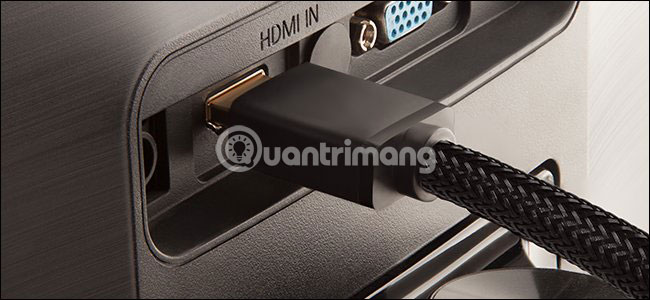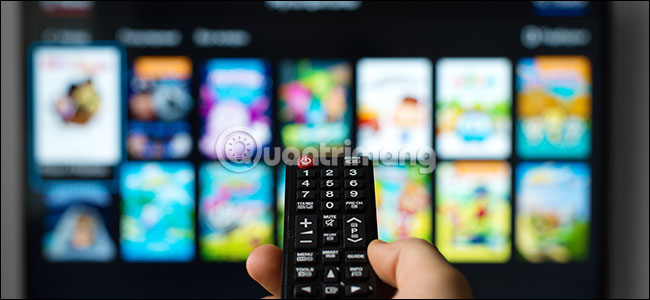What is wireless HDMI? Should I use it?
Wireless HDMI products (Wireless HDMI) have been around for nearly a decade, but they haven't really become popular. Today, TipsMake.com will work with readers to find out how wireless HDMI works and whether to buy wireless HDMI products without the following article.
Learn about wireless HDMI
- Wireless HDMI is an alternative to HDMI cables
- Wireless HDMI is like Bluetooth, but only for videos
- Why is wireless HDMI not the global standard?
- Wireless HDMI is a unique product
Wireless HDMI is an alternative to HDMI cables
HDMI cable is the standard medium for high-definition video transmission for more than a decade. But HDMI cables have some obvious drawbacks. Some unreliable HDMI cables can turn your 'entertainment center' into a 'mouse nest' and they restrict the movement of cable boxes or game consoles in a certain space.
HDMI wireless is a high-definition video solution, which can solve some HDMI-related problems. You can clean up your entertainment center, play a single video source for all indoor TVs or project your phone or computer screen to TV.
There are many wireless HDMI products on the market and all are easy to install. Just plug in a device that emits the HDMI port of the video source and the HDMI input device of the TV, that's it!
Wireless HDMI is like Bluetooth, but only for videos
Unlike screen projection applications like Apple AirPlay, wireless HDMI requires WiFi connection. The transmitter plugged into the video source will emit the frequency and the device plugged into the screen will decode that frequency into a high-definition video. Think of it as Bluetooth, but only for videos.
Some wireless HDMI products have an integrated infrared transmitter. These infrared transmitters allow the use of a TV control to control remote devices. These devices are also needed for many wireless HDMI settings.
Like any wireless transmission, wireless HDMI is easily blocked. Most wireless HDMI products operate at 5GHz, which can be blocked by WiFi and mobile phone signals. Thankfully, most new wireless HDMI products use the frequency selection feature to automatically adjust the congested frequency, at least within the home.

But when it comes to wireless HDMI, latency is an inevitable hindrance. A video signal must be encoded, transmitted, received and decoded before it is displayed. Therefore, most wireless HDMI products have a bit of lag.
Products like J-Tech Digital HDbitT, with a range of 660 feet (183m), have a delay of several milliseconds. Products like Nyrius ARIES NPCS549 with a range of 30 feet (9m) have a delay of only a few microseconds (undetectable).
Until now, gamers may have realized that wireless HDMI solutions are not suitable for playing Xbox games around the house, but they can be used to replace HDMI cables in entertainment centers.
Why is wireless HDMI not the global standard?
If the wireless HDMI is so great, why not replace the HDMI cable? There are no standards for wireless HDMI and no expensive wireless HDMI products on the market are compatible. Manufacturers can combine and upgrade wireless HDMI as a new standard for home video, but to be honest, manufacturers don't have much incentive to develop technology to replace streaming formats. Super fast data like USB-C.
Right now, WHDI is the leading wireless HDMI option. WHDI operates at 5GHz, supports 1080p and 3D video. Sadly, WHDI does not support 4K and often interferes with routers and mobile phones. The push for global adoption of WHDI took place about a decade ago and many companies like Sharp and Philips actually integrated WHDI receivers into some TVs. Unfortunately, these products do not make a big sound.
Some other wireless HDMI formats are no longer used, including WiGig, support for 4K and WirelessHD videos, with fairly good data transfer rates. But there aren't any new products that support these wireless formats and they will eventually be forgotten.
Wireless HDMI is a unique product
Although wireless HDMI can be extremely useful for some people, it does not have much potential to be widely adopted or used in practice. There are many problems with wireless HDMI and unless you are trying to 'clean up' your entertainment center or broadcast cable signals to the basement, there is no reason to accept this format.
The biggest problem with wireless HDMI is the price. Most wireless HDMI sets cost about $ 200 (4,600,000 VND). They also have only one transmitter and receiver only.
The amount of money for wireless HDMI products is huge but they do not support 4K, so users may have to 'sacrifice' part of the video quality. Not to mention, most wireless HDMI products can only communicate with one transmitter or receiver at a time. Playing a single video source to multiple TV receivers is too expensive and difficult.

Latency is another concern. TV viewers do not need to worry about the delay of several milliseconds, but the delay due to wireless HDMI settings can make video games unplayable. There are some HDMI products that completely eliminate latency for gamers, but they only have a range of about 30 feet (more than 9m).
Of course, there are some situations where HDMI can play its role. Instead of paying for a cable TV company to have a set top box in each room, you can buy some wireless HDMI sets to play a single cable box. for the whole house. These wireless HDMI devices will last for a long time so users can use them for other applications in the future.
Wireless HDMI is also a great way to clean up the entertainment center. If you don't want to spend $ 1000 (23,000,000 VND), you can always pair the transmitter with the HDMI switch and remove most HDMI cables. In addition, wireless HDMI can make the use of home projectors much more convenient, since there are no longer any cables to hang on the ceiling.
Will wireless HDMI become the global standard for video transmission in the future? Nobody can say anything. But at least HDMI wireless can replace the indoor HDMI cable if there is an appropriate usage.
You should read it
- All things need to know about HDMI 2.1 standard
- Officially released HDMI 2.1 standard that supports 10K video and Dynamic HDR
- Learn about HDMI and HDMI switch
- Best HDMI cable for monitors, LG TVs, Samsung and Apple TVs
- What is HDMI-CEC?
- The 5 best HDMI splitters of 2023
- Decoding HDMI sign (STB) on TV
- What is HDMI eARC?
May be interested
- World wireless technology
 wireless technology is everywhere. with any application or service related to data transport, there is a wireless solution. new technologies are coming out that are expected to promise a completely wireless world
wireless technology is everywhere. with any application or service related to data transport, there is a wireless solution. new technologies are coming out that are expected to promise a completely wireless world - Basic guide: wireless network - Wireless
 this article shows you how to set up or 'tune' your wireless network, then connect more printers, music players, and tvs to this wireless network.
this article shows you how to set up or 'tune' your wireless network, then connect more printers, music players, and tvs to this wireless network. - The best true wireless headphones on the market - when convenience comes to the throne
 true wireless headphones start to appear everywhere. how do these devices work? sound quality like? and how important is the selling price?
true wireless headphones start to appear everywhere. how do these devices work? sound quality like? and how important is the selling price? - Top best wireless mice 2019
 wireless mice have become the standard for interacting with computers, and among hundreds of tested mice, logitech mx master 2s is a product that meets almost every user's needs.
wireless mice have become the standard for interacting with computers, and among hundreds of tested mice, logitech mx master 2s is a product that meets almost every user's needs. - Wireless LAN security (Term 2)
 a wireless lan consists of three parts: wireless client, access points and access server. the typical wireless client is a laptop with a wireless nic (network interface card) installed to allow access to the wireless network. access points (ap) provide three
a wireless lan consists of three parts: wireless client, access points and access server. the typical wireless client is a laptop with a wireless nic (network interface card) installed to allow access to the wireless network. access points (ap) provide three - 4 tips for building better wireless networks
 how much performance do companies want to implement when they deploy a wireless network? these cases may not be enough - especially when wireless becomes a key part of the new data center infrastructure.
how much performance do companies want to implement when they deploy a wireless network? these cases may not be enough - especially when wireless becomes a key part of the new data center infrastructure. - 7 troubleshooting tips for Wireless N networks
 in this tutorial we will show you some tips on troubleshooting to make your network work as best as possible for wireless n.
in this tutorial we will show you some tips on troubleshooting to make your network work as best as possible for wireless n. - What is Wireless Powershare?
 wireless powershare is an innovative feature that allows you to turn galaxy note 10, note 10+, galaxy fold, etc. into a wireless charger. let's find out more about this feature through the following article.
wireless powershare is an innovative feature that allows you to turn galaxy note 10, note 10+, galaxy fold, etc. into a wireless charger. let's find out more about this feature through the following article. - How to charge the iPhone wirelessly?
 with the dizzying increase of smartphones, the popularity of wi-fi and bluetooth, and the dominance of cloud services like icloud and dropbox, the future of wireless gadgets is becoming increasingly clear. clearer than ever. much of the iphone usage has been wireless experiences, including removing connection cables or synchronizing phones with computers over the internet. charging the iphone battery is one of the last areas that still requires using cables. but this will not be long.
with the dizzying increase of smartphones, the popularity of wi-fi and bluetooth, and the dominance of cloud services like icloud and dropbox, the future of wireless gadgets is becoming increasingly clear. clearer than ever. much of the iphone usage has been wireless experiences, including removing connection cables or synchronizing phones with computers over the internet. charging the iphone battery is one of the last areas that still requires using cables. but this will not be long. - How to Connect Wireless Headphones on PC or Mac
 this wikihow teaches you how to connect wireless headphone to your pc or mac. you can easily connect wireless headphones using bluetooth. turn on your wireless headphones. make sure your wireless headphones have plenty of battery life.
this wikihow teaches you how to connect wireless headphone to your pc or mac. you can easily connect wireless headphones using bluetooth. turn on your wireless headphones. make sure your wireless headphones have plenty of battery life.










 Learn about PGP (Pretty Good Privacy)
Learn about PGP (Pretty Good Privacy) What is Maftask?
What is Maftask? Why is Windows slowing down after a period of use?
Why is Windows slowing down after a period of use? What is RFID? What role does RFID play in IoT devices?
What is RFID? What role does RFID play in IoT devices? Security vulnerabilities - basic insights
Security vulnerabilities - basic insights Build your own computer, build your desktop (P4): Install Windows and drivers
Build your own computer, build your desktop (P4): Install Windows and drivers